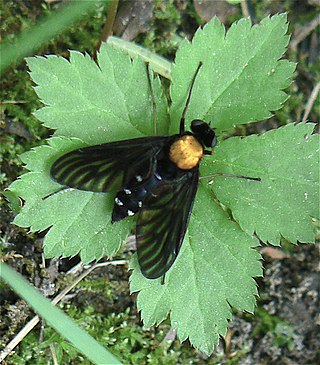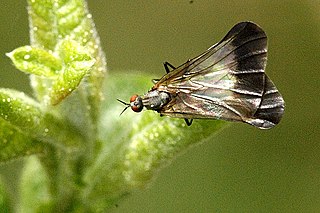
Chrysopilus is common, worldwide genus of predatory snipe flies. There are approximately 300 species in the genus, including fossil members that are sometimes found in amber.

Rhagionidae or snipe flies are a small family of flies. They get their name from the similarity of their often prominent proboscis that looks like the beak of a snipe.

Tachydromia is a genus of hybotid flies. It is widespread around the world, with species found essentially everywhere except the polar regions and some remote islands. They are not very diverse in East and Southeast Asia, or in Africa

Rhagio is a worldwide genus of predatory snipe flies. Several species in this genus are referred to as downlooker or down-looker flies because they sometimes perch on tree trunks in a head-down position. There are approximately 170 species. They can be distinguished from other rhagionids by the open anal cell on the wings and the lack of a kidney-shaped arista.

Ptiolina is a genus of snipe flies of the family Rhagionidae,. Examples are found in Northwest Europe, where it prefers woodlands areas. and North America

Rhamphomyia is a genus of dance flies, in the fly family Empididae. It contains more than 600 species in 8 subgenera.
Austroleptis is a genus of snipe flies, and the sole genus in the family Austroleptidae; until 2010, it was placed in the family Rhagionidae. They are small to moderately sized flies of around 3 to 7.7 mm.
Alloleptis is a genus of snipe fly of the family Rhagionidae. It is a small fly of about 4 mm and only known from Sulawesi. It currently contains only one species, Alloleptis tersus.
Schizella is a genus of snipe flies of the family Rhagionidae. They are delicate flies from 3.7 to 6.3 mm, with long, thin legs, and the thorax is brown to orange-brown with blue, purple, or golden-coloured setae.

Hybos is a genus of hybotid flies.

Oxycera is a genus of flies in the family Stratiomyidae.

Chorisops is a genus of flies in the family Stratiomyidae.

Rachicerus is a genus of flies in the family Xylophagidae.

Atherix is a genus of 'ibis flies' belonging to the family Athericidae, a small family very similar to the Rhagionidae. Species within this genus are present in most of Europe and also in the Nearctic realm.

Solva is a fly genus in the family Xylomyidae, the "wood soldier flies".

Ptiolina obscura is a species of 'snipe flies' belonging to the family Rhagionidae.

Xylomya is a fly genus in the family Xylomyidae, the "wood soldier flies".

Chrysopilus quadratus is a species of snipe fly in the family Rhagionidae.

Spaniinae is a worldwide subfamily of predatory snipe flies.
Atrichops is a genus of flies in the family Athericidae.














